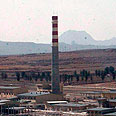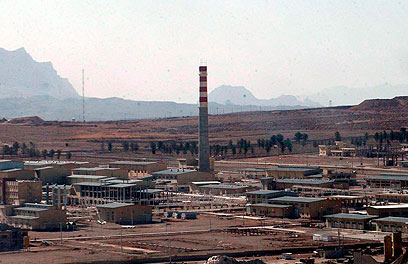
'Iran blast – near military academy'
Iranian website says explosion occurred on street adjacent to military school. Meanwhile, satellite images of site hit by blast two weeks ago reveals extensive damage. Analyst: Impossible to tell whether blast caused by sabotage
While Iranian officials continue to deny any reports on the blast in Isfahan, other sources started to shed light on the mysterious incident.
Iranian paper Farhang Ashti (Peace Culture) reported Monday that the explosion, which was initially reported by Iran's official news agency Fars, took place several streets away from the city's military academy, near the Shiraz Gate.
Related stories:
- Iran: We'll fire 150,000 missiles at Israel if attacked IDF: Iran blast harms missile development program Report: Huge blast heard in Iranian city of Isfahan
The report's credibility remained unclear.
Fars initially reported a loud blast at 2:40 pm local time, but removed the report shortly afterwards. Hours later, conflicting reports began to surface.
Iran's Mehr news agency mistakenly quoted the deputy governor of Isfahan province as saying that there was no report of a major explosion in the province – a quote given by him almost a year earlier, following a December 18, 2010 explosion in the city.
True or false? The original report in Iran
However, the news agency also quoted another Iranian media outlet as saying that a blast took place at a petrol station in a nearby town. Iran's uranium conversion plant is located just outside Isfahan – one of the country's largest cities.
'Iran's most senior scientist'
Earlier on Monday, Iran's Foreign Minister Ali Akbar Salehi said that Majid Shahriari, who was assassinated last year in Iran, was the Islamic Republic's "most senior scientist." This is the first time an Iranian official has referred to Shahriari in such a manner in public.
In a radio interview, Salehi added that Shahriari, who was assassinated on November 29, 2010, was the only scientist able to produce enriched uranium at a 20% rate.
Also on Monday, the Washington Post published satellite images showing extensive damage to the Iranian missile base that was hit by a mysterious explosion two weeks ago.

Uranium conversion facility near Isfahan (Photo: EPA)
The image of site, obtained by a Washington-based research group, did not reveal any clues as to what caused the blast, but showed that the facility has been effectively destroyed.
Senior analyst at the Institute for Science and International Security, Paul Brannan said it’s impossible to tell from the image whether the blast was caused by sabotage, as had been speculated.
When performing work with missiles, there are a variety of “volatile processes” that could cause an explosion, Brannan told the Washington Post.
Brannan added that his institute was recently informed by sources privy to the situation, that the blast had occurred just as Iran had achieved a milestone in the development of a new missile and may have been performing a “volatile procedure involving a missile engine at the site.”
Yitzhak Benhorin contributed to this report
- Receive Ynetnews updates directly to your desktop











